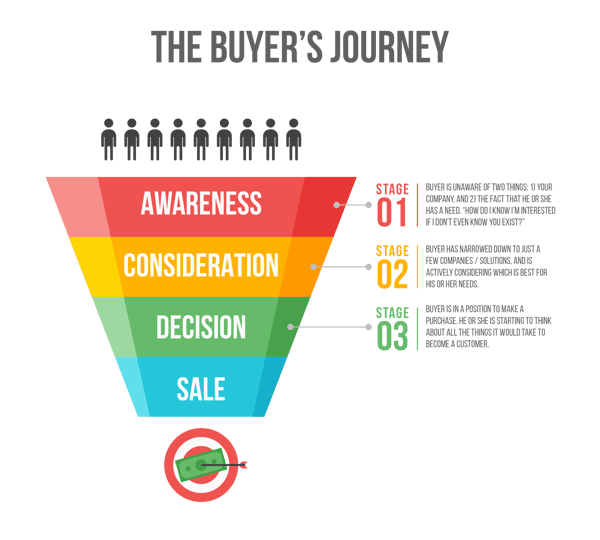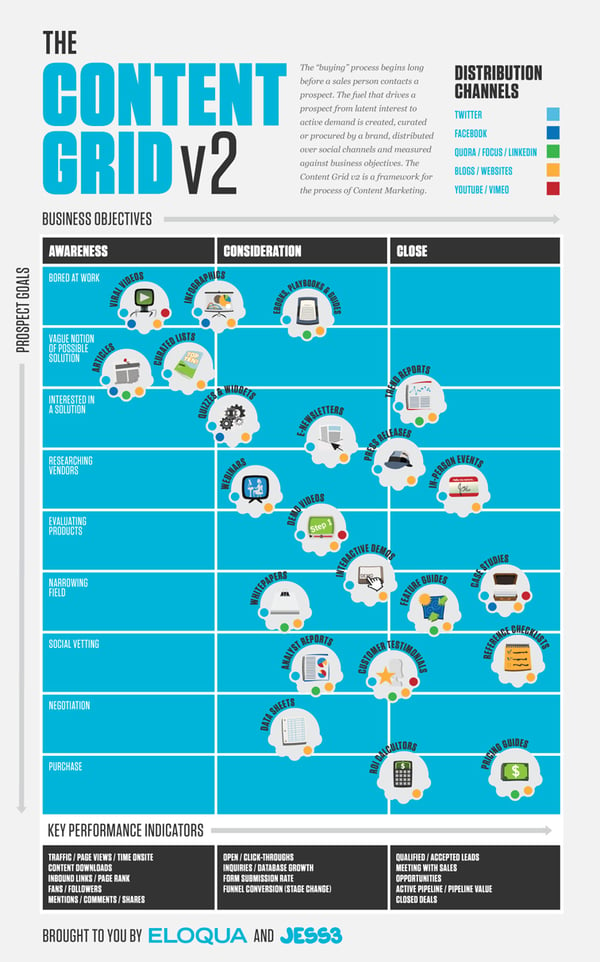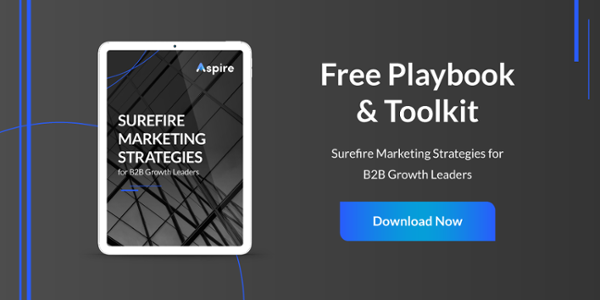As a small business owner or leader, it can be tough to decide how and what types of content to create for your business. Between blog posts, white papers, case studies, checklists, webinars, eBooks, and more, it's understandably easy to get overwhelmed!
There are some key pieces of homework that you can do to make this process easier. Creating strong buyer personas is the first key step. The second is making sure you've done SEO keyword research so you understand what your personas are searching for.
But what if you've already done this legwork? Even then, given the plethora of content types you could create, how do you decide what content to create and how to prioritize it?
The key is to understand your buyer's journey, or the path your typical buyer will go through to research and evaluate solutions before deciding what to buy. Once you've done that, you can create content to support your buyer during each step they might take in the journey.
What is the Buyer's Journey?
For most products, a customer doesn't just choose to buy it on a whim. This is especially true in B2B buying, where it's rare that a single person has the ability to make a substantial purchasing decision without input or approval from others. Instead, your buyer goes through a process of research and involving various decision makers until they are ready to buy.
The buyer's journey is often represented in the form of a marketing or sales funnel. The funnel describes the different stages your personas go through leading up to their purchase.
To build out great content, your aim is to write content that helps your personas get through each portion of their buyer's journey. The more you can support their buyer's journey with the use of helpful, insightful content, the more likely they are to turn into your paying customer.
What Are the Three Stages of the Marketing Funnel?

You can think of your funnel as being split into three separate and equally important phases: Awareness, Consideration, and Decision. This is often described as the Top, Middle, and Bottom of the Funnel (or abbreviated as TOFU [Top Of FUnnel], MOFU, and BOFU). Again, your goal is to provide as much content as possible to enable your customer at each step of the funnel. But before you do that, it's essential to understand each stage in the funnel.
Awareness
The Awareness stage is where your buyer is unaware of one or both of these things: 1) your company, and/or 2) the fact that they have a need to be solved. Often, the prospect may be experiencing and even expressing symptoms of this problem, but they haven't put a name to the problem or they don't fully understand it. So, they go out and do research.
A lot of companies forget about this stage of the funnel, and focus on only the latter stages by churning out lots of data sheets, case studies, brochures, and the like. The thing is, if your buyer doesn't even know they have a problem, then this kind of content is not helpful at all.
Consideration
The Consideration stage is where the buyer has clearly identified the problem and is beginning to narrow in on some solutions to it. They are continuing to do lots of research here, however, so they're still not ready for you to sell them hard on your solution. Again, lots of companies are eager to jump the gun and start selling. But that still isn't going to be effective in the consideration stage. Continuing to provide education and insights is just as critical here, even if the insights are more targeted toward helping them narrow in on your solution.
Decision
At the Decision stage, the buyer has decided on how they're going to solve the problem. At this point, they're probably compiling a list of vendors that meet their needs, and then working to narrow down to a single vendor and make the purchase. This is where your traditional sales-y marketing materials come into play, like case studies, feature guides, and more.
Creating Content for Each Part of the Funnel
Remember, your prospect's needs are very different in each stage of the funnel. To create an effective content plan, you will need to have content for each stage of the funnel and for each persona. You'll want to think about your prospect's objectives during that stage of the funnel, and what types of content will enable them to meet those objectives.
Certain types of content are most effective at certain stages in the funnel. For example, a case study would not really be helpful to a prospect that's in the awareness or consideration stages, since they're not yet ready to narrow in on a vendor.
One of our favorite graphics that's stood up to the test of time is the Content Grid from Jess3 and Eloqua:
 The Content Grid, as shown above, is a great reference for what types of content are effective at what stages of the funnel.
The Content Grid, as shown above, is a great reference for what types of content are effective at what stages of the funnel.
Content for the Awareness Stage
The biggest mistake companies make in the Awareness stage is wanting to talk about themselves. That's really not a fit for what your prospects are looking for in this stage of the funnel. Promotional, salesy content just won't work here. Save it for the Decision stage and limited use in the Consideration stage. Being too salesy or promotional here will turn off customers and have them go elsewhere for their research and information. And if they do that, there's a risk they may not return to you when they are ready to start considering and deciding on a solution. So, what types of content are effective in the Awareness stage?
Blog Posts
For the Awareness stage, your company blog is going to be your most important asset. Creating lots of valuable, quality, SEO and keyword driven content is critical here.
Indeed, an effective blog post is rooted in your SEO research and focused on a specific keyword or topic that's relevant to your audience. What are some other keys of a great blog post?
- A strong, compelling headline
- A compelling introduction
- Meaty body content – blog posts shorter than 500 words are often not valuable or insightful enough, and many times posts longer than 3,000 to 4,000 words can be split into multiple, shorter posts
- Isn't just text – whether you weave in some graphics, infographics, or data visualizations, this helps make it easier to read
- A strong conclusion that reiterates the key points
- A call-to-action – your goal is always to keep your prospect continuing through their journey without leaving your site, so a strong call-to-action to the relevant next piece of content is a must
Videos
The human attention span has been shown to be shrinking. You have less time than ever to capture your personas' interest, and it's harder than ever to keep it. Videos are a great way to create compelling, digestible content for your audience. Lots of companies shy away from video because they're afraid they would have to spend too much money and time to create hyper-professional videos. In reality, people have become conditioned to be skeptical of videos that look excessively promotional. You can often film a video with a modern phone camera that is of sufficient quality. What are some good videos that are effective at the Awareness stage?
- How-to or educational videos
- Expert interviews
- Explainer videos
Infographics
Speaking of the limited human attention span, infographics can be incredibly powerful in the Awareness stage. Great infographics articulate somewhat complex data in an easy to digest way. The other great thing about infographics is that they are highly sharable. Don't forget to include your logo and website link at the bottom of your infographic, in case others share it, so that you get credit!
Social Media
We can't talk about Awareness without talking about social media. Pew Research has found that 72% of people use some form of social media. Most likely, your personas are active in some way on social media. If your company serves B2B customers, it's likely that LinkedIn is going to be your most successful channel. There are also niches of B2B customers active on Twitter and Facebook, and sometimes even Instagram and other networks. And again, on the topic of shortened attention spans, the other great thing about social media is that it tends to be short and quick for your audience to read.
Content for the Consideration Stage
Now that you have your bases covered from an Awareness perspective, it's time to focus on the second part of the funnel. In the consideration stage, your prospects will have a deeper understanding of their problem. Now, they are trying to thoroughly research the solutions to that problem.
Consideration is the stage where you'll start getting more into your product or service itself. Still, you need to be careful here. In general, prospects in Consideration still aren't ready to be aggressively sold to. You can still risk turning them off by being too promotional. Instead, your focus should still be on providing helpful information so that you can ensure your product or service is part of the set of solutions they consider in the Decision stage.
What kinds of content should you consider for the consideration stage?
eBooks, Playbooks, and Guides
Now we're starting to talk about "gated," downloadable content you can offer your audience. The key to succeeding with downloadable content like this is that it is well-written and valuable enough that your prospects are willing to exchange some of their contact information in return for receiving it. Then, you require them to fill out a form and provide that contact information to get their download.
The risk is that if you create low quality or promotional content, prospects are going to feel burned and tricked once they've given you their valuable contact information to receive it. That's not a good way to start building relationships with your potential customers.
eBooks, playbooks, and guides tend to be shorter form downloadable content. The design and layout of these are often heavier on the graphics, which makes them feel a bit "lighter" than, say, a white paper.
Quizzes
Quizzes can be a highly effective way to generate and capture leads. These are fun and highly sharable with friends and colleagues on social media. A successful quiz will be relevant to your areas of expertise and knowledge, and to your buyer personas – not on random, unrelated topics. You can require those taking your quiz to provide an email address before they can see the results.
Webinars
We believe that webinars, when done correctly, can be one of the most effective types of content marketing. What are the rules of a great webinar?
- It will be packed with educational insights and information – not promotion and selling for your product or service. In an hour-long webinar, you might carve out the last 5 or so minutes to talk about your offering, but no more. You are asking your prospects to make a real time commitment to attending your webinar, so don't waste their time (or again, you risk souring the relationship permanently).
- It will be extremely well planned and rehearsed. You will have lots of useful information. Your speaker won't have issues connecting and will be an expert who is extremely comfortable with the materials. You will know the webinar software inside and out. You will have rehearsed multiple times prior to the presentation.
- It will have all attendees muted and unable to unmute themselves. You don't want your attendee who is waiting for a bus or at the airport cutting in and making it so no one can hear you. Or, having an attendee cut you off and disrupt your momentum with a question.
- It will set aside time for Q&A. You want your audience to be able to ask questions. Ideally, you will unmute question askers one at a time, or even require them to type their questions into a chat and then you can reply to them in real time.
- It will have a plan for strong follow up. Depending on your company's approach to sales and marketing, you might have a series of marketing emails go out to attendees. Or, you might have a sales rep follow up with every person who attends.
One more pro tip for you: don't try to do a webinar on your own! As a small business, it can be really hard to get a lot of people to turn out for your webinar. First, you may not to have the reach necessary to generate lots of attendees on your own. Second, even if you do have a lot of reach, just having a good webinar is often not enticing enough to draw people in. Again, they are committing a chunk of their day's productivity to attending your webinar! Instead, we recommend finding a partner in your industry with a large reach and high credibility (who is not your competitor). You could look to do a joint webinar with them, or perhaps paying them for a sponsored webinar.
White Papers
We love white papers, but the problem is that there's often a huge misconception about what a white paper actually is. Lots of white papers turn out to be advertisements for the product or service you are offering. Again, like eBooks, making people give you their contact information for what amounts to essentially an advertisement is bad marketing and bad business.
A good white paper will be detailed, technical, and offer unique insights that your readers can't get elsewhere. That's the major difference between a white paper and an eBook: a white paper will be a technical deep dive, and heavy on the written content; an eBook will be less technical and less deep, more accessible, and have a lot of design elements to divide up the written content.
Data Sheets
Ok, this is finally where you can start bringing in that traditional marketing collateral! Data sheets are valuable really late in the Consideration stage, when your prospect is getting close to moving into the Decision stage.
Content for the Decision Stage
The final stage of the funnel is the Decision. This part is when a visitor has consumed all your content and has narrowed in on your product or service as a potential solution. If you've gotten a prospect to this point, this is where your content is about you and how you're different from your competitors. Don't forget here that one competitor you're always facing in the Decision stage is "no decision" – where they decide they are content with living with the problem or making it work with whatever solution they currently have.
With all that in mind, let's look at some of the content you might need when a persona has reached the decision stage of his or her journey.
Feature and Product Comparison Guides
This is where you can start to really help people understand, in-depth, the features and benefits of your offering. You can also discuss how and why you're different from your competitors.
Case Studies
For obvious reasons, people like to buy things that are trusted by others. In psychology, demonstrating is known as social proof. Your case studies should be focused on the various problems and types of personas you have. If you can show that your solution has successfully solved a similar problem at a similar company, your prospects will be much more comfortable buying from you.
A great structure for case studies is to divide it into three sections: Problem, Solution, and Results. The more detailed and quantified each of these sections is, the more likely the case study will compel your prospect to buy from you.
ROI Calculators and Pricing Guides
At some point in the Decision process, price will become a factor for your prospect. Having guides to help frame your price and the value it provides is critical to helping close the deal.
Free Consultations and Trials
Finally, the best way to let your customers decide if they want to use your product or service is to give it a try. This is especially common with software offerings. And if you offer a service or have a product where a free trial isn't possible, a free consultation can be a great way to continue to add value to your prospect and get them closer to buying your offering.
Start Small and Work Your Way Up
In this guide, we've covered at least a dozen different types of content your business could create. But let's not forget: you are running a business, and taking on creating all of that content may seem daunting. So, what are you to do?
The first thing is to prioritize. As you create a map of the content you need to create for each persona, think about what content is most important to enabling your persona's journey. Start there. And you often will want to start at the top of the funnel and work your way down. If you don't have a lot of Awareness content, you're probably not attracting a lot of new visitors to your site, so it doesn't make sense to create Consideration or Decision content yet.
You can also look for a trusted partner to help you create your strategy and create your content. Aspire offers a full range of inbound and content marketing services to help support your business' growth.
Having a Content Plan Is Vital
Bill Gates famously wrote back in the Internet's infancy (1996) that "Content is king." This holds true today as much as ever. Small businesses are often eager to get into the content game, knowing that their competitors are doing the same.
But if you jump in without a strategy, you can't expect to get consistent results from your content marketing. By creating a map of content you need to create for each persona and each step in their journey, you will be in a great position to create high-quality content that inspires people to take action.
Aaron Marks is the Chief Marketing Officer of Execo. A digital pioneer with nearly two decades of online marketing experience, Aaron has helped organizations ranging from fledgling startups to Fortune 500 enterprises, and global manufacturers to U.S. Presidential campaigns, get the marketing and business results they needed.


0 Comments